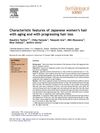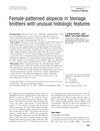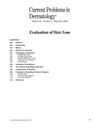Clinicopathological Insights into the Phenotypic Variation of Autosomal Recessive Hypotrichosis/Wooly Hair by c.736T>A LIPH Mutation
September 2016
in “
Journal of dermatological science
”
autosomal recessive wooly hair hypotrichosis LIPH mutation c.736T>A dermoscopic analysis terminal hairs vellus hairs hair density histopathological examination hair miniaturization telogen/anagen ratio topical minoxidil wooly hair hair loss LIPH gene hair analysis hair thickness hair growth cycle Rogaine
TLDR The conclusion is that the variation in hair thinness in patients is mostly due to the amount of underdeveloped hairs, and treatments that thicken fine hairs might work for those with mild to severe conditions.
The study investigated the phenotypic variation of autosomal recessive wooly hair/hypotrichosis (ARWH/H) caused by the LIPH c.736T>A mutation in eight Japanese homozygotes. The patients were categorized into three groups based on the severity of hypotrichosis: intensely severe (1 case), severe (3 cases), and mild (4 cases). Dermoscopic analysis showed a decreased ratio of terminal to medium-sized vellus hairs in mild and severe cases, with a significant reduction in hair density in the intensely severe case. Histopathological examination of a mild case revealed hair miniaturization and a high telogen/anagen ratio without a decrease in total hair count. Mild and severe cases showed improvement with age or topical minoxidil, while the intensely severe case did not improve. The study suggested that the frequency of underdeveloped hairs contributes to the clinical diversity of hair sparseness in these patients, and that treatments aimed at thickening fine hairs could be beneficial for mildly to severely affected individuals.







